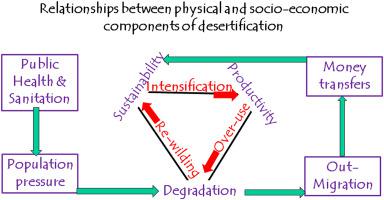Journal of Arid Environments ( IF 2.6 ) Pub Date : 2021-06-16 , DOI: 10.1016/j.jaridenv.2021.104575 Mike Kirkby

|
The dominant direct physical processes responsible for desertification are water erosion, wind erosion and salinization. Other threats that degrade the soil include loss of biodiversity, loss of soil organic matter, fire, changing water resources, soil compaction, soil sealing and contamination. Soil management inevitably combines human and physical effects. Climate, which is the most important driver of the physical systems, is now being rapidly modified by human action, and at a scale which is much coarser than any local remedial action. In a model of near-subsistence systems, productivity is limited by climate and available labour, with some options for additional inputs through improved seed, fertilizer or tillage equipment. Optimum solutions in a particular environment depend on both climate and access to markets. Agricultural surpluses, if any, allow investment in infrastructure – some of it directly supporting agriculture through irrigation and market systems, some less directly useful through, for example, warfare or pyramid building. Today some traditional drivers of desertification, based on subsistence agriculture and grazing, may have become less relevant, as land, particularly in the global South, is developed for intensive irrigated farming, and populations move into mega-cities. The dominant drivers may become soil sealing around cities and transfers of urban and irrigation water. In semi-arid areas this will lead to competition for the best land – for urban expansion and agricultural land with irrigation potential. Desertification then becomes an issue increasingly focussed on abandoned marginal land, maintaining biodiversity, managing regional water resources and controlling erosion in the face of global climate change.
中文翻译:

荒漠化与发展:一些更广泛的背景
造成荒漠化的主要直接物理过程是水蚀、风蚀和盐碱化。其他导致土壤退化的威胁包括生物多样性丧失、土壤有机质丧失、火灾、水资源变化、土壤板结、土壤封闭和污染。土壤管理不可避免地将人类和物理效应结合起来。气候是物理系统最重要的驱动力,现在正在被人类活动迅速改变,其规模比任何局部补救行动都要粗糙得多。在近乎自给系统的模型中,生产力受到气候和可用劳动力的限制,一些选择通过改进种子、肥料或耕作设备来增加投入。特定环境中的最佳解决方案取决于气候和市场准入。农业盈余,如果有的话,允许对基础设施进行投资——其中一些通过灌溉和市场系统直接支持农业,另一些则通过战争或金字塔建设等不那么直接有用。今天,一些以自给农业和放牧为基础的传统荒漠化驱动因素可能变得不那么重要了,因为土地,特别是在全球南方,被开发用于集约灌溉农业,以及人口迁移到大城市。主要驱动因素可能是城市周围的土壤密封以及城市和灌溉用水的转移。在半干旱地区,这将导致争夺最好的土地——城市扩张和具有灌溉潜力的农业用地。然后荒漠化成为一个问题,越来越关注被遗弃的边缘土地,保持生物多样性,











































 京公网安备 11010802027423号
京公网安备 11010802027423号